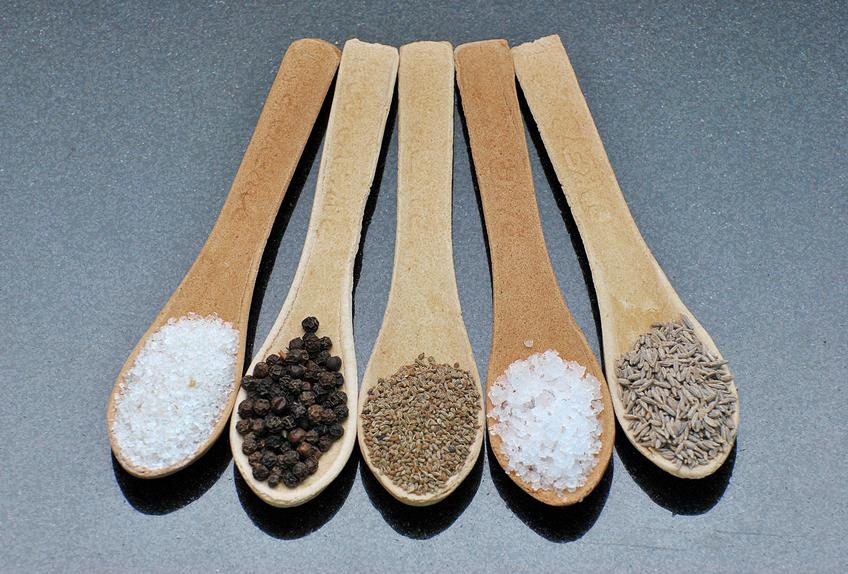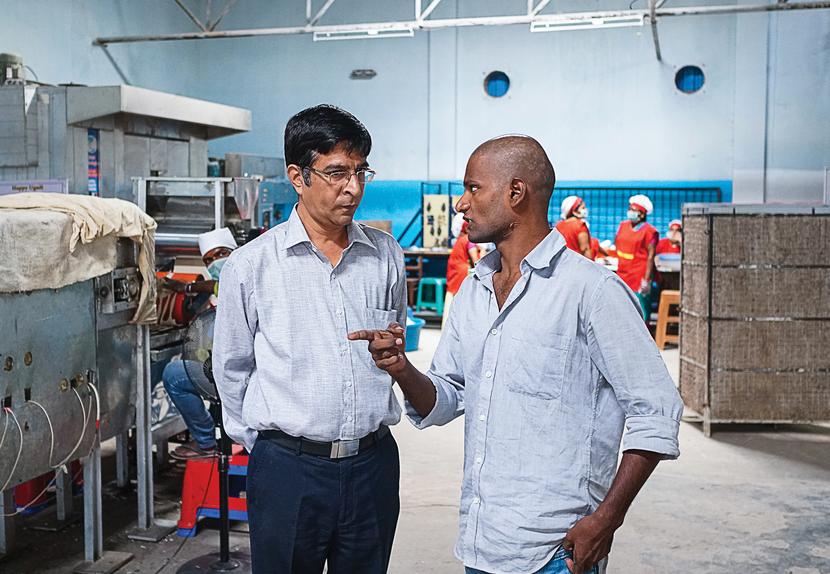


A DECADE AGO, Indian scientist Narayana Peesapaty set out to reinvent the humble disposable spoon. If we could eat our utensils after a meal instead of throwing them out, he figured, that would go a long way toward slowing the world’s rising tide of plastic garbage. But first he had to work out a few baking problems. The spoons he was trying to create—mostly out of sorghum, a gluten-free, nutrient-rich grain—had to be thin enough to scoop up food and hard enough not to get soggy in hot soup or coffee. The pieces he was actually producing looked more like spatulas and cracked apart in the oven. Then, of course, there was the matter of taste: His spoons couldn’t overpower the food they were serving up, but if they weren’t appetizing enough, people might still toss them after use. When he tried putting sugar in the dough, the spoons swelled during baking and stuck to their molds. Adding garlic caused the molds to smell.
Now Peesapaty is producing tens of thousands of spoons a day—plain ones, savory ones and sweet ones, too, though he only recently figured out how to keep those from sticking—and eyeing global expansion. His company, Bakeys Foods Private Limited, is still a modest operation, one he manages partly out of his family’s apartment in Hyderabad, with a small factory about 10 miles away. In his grandest ambitions, though, he envisions Bakeys spoons not only shrinking our landfills and reducing our intake of the chemicals in plastic, but also helping to change the way India grows its food in time to stop the country from turning into an arid wasteland.
Slim and mild-mannered, Peesapaty, 50, had a disenchanting first career that he now calls “a disaster.” During his 18 years as a scientific consultant and researcher, he could never stand it when his fellow scientists would discover something potentially world changing—and then say it was someone else’s job to go out and change the world with it. “I wasn’t really satisfied with that,” he says.
His own big discovery didn’t happen in the lab at all. On a field visit not far from Hyderabad, in the sorghum-growing district of Mahabubnagar, he was served roti, or flatbread, made from the grain. The bread hardened as it cooled, perfect for shoveling up curry and lentils. Sometime later, staring at the white plastic spoon that came with an in-flight meal, he remembered that roti. “So many million tons of plastic garbage,” he thought. “Can we not do something about this?”
He quit his job in 2006 and got baking. His earliest creations barely resembled spoons at all—“very, very, very raw,” he says. Worse, they kept breaking before they came out of the oven, and no amount of fiddling with the process helped. Peesapaty didn’t figure it out until more than a year later, with his arm in a sling after a motorbike accident (“Don’t think and drive,” he counsels) and his factory producing nothing but gunnysacks full of broken spoons. The secret, he says, is in how the dough gets treated during kneading. He declines to say more.
Selling the spoons proved difficult. He hawked them outside grocery stores and in parks. “People were just not interested,” he says. Stress turned him into a loner and wrecked his health, says his wife, Pradnya Keskar, whose job at a foundation supported their family and Peesapaty’s spoon making for years. They avoided their relatives—too many awkward questions about how the business was doing—and rationed their gas and grocery spending.
By early this year, they’d gotten a few largish orders. Peesapaty himself flew to Chennai to deliver the first one, to the owner of an eco-goods store who wanted a few hundred spoons on short notice for her son’s birthday party. But overall things were looking bleak. The bank was threatening to take their apartment. And Peesapaty got lost in thought on his motorbike again, this time breaking his collarbone. When a team commissioned by the Better India, a Bangalore-based website that focuses on uplifting news stories, came to shoot a video about Bakeys, Peesapaty went on camera with a bandage peeking out from under his shirt. “Everything that could go wrong was going wrong,” he says.
Then on March 15, the three-minute, 40-second clip went live on the site, and everything exploded. Emails started flooding in at one per second. Each time Peesapaty finished taking one call, he’d hang up and find dozens more waiting. The Better India had previously published a short article on Bakeys that had gotten good traffic, so Dhimant Parekh, the site’s co-founder, figured the video, made for around $2,500, would go big too. “Not this big,” though, Parekh says. “Not this big at all.” Other sites and news outlets picked up the film, helping it spread with astonishing speed. It racked up 100,000 views in the first half-hour and five million in the first week, says Parekh.
Over the next few months, Peesapaty and Keskar heard from interested buyers from far and wide: refugee camps in Europe, schools in Pakistan, luxury hotels in India. People also started showing up at their apartment unannounced. One person wouldn’t leave until the couple took his order. Another kept coming every two weeks or so. For a while, the couple had at least one Chinese visitor per week. Several letters from China were even written in Hindi. “It was beautiful,” Keskar says. “Mere bhai,” one letter began—my brother. “We want to do business with you. Can we come to meet you? It would be an ideal partnership.”



Between their own website, which for a long time they hadn’t had enough money to update, and two crowdfunding campaigns, the couple took orders for 7.5 million spoons before deciding in mid-April that their factory would be overwhelmed if they took any more. They brought in a custom-built oven, one they’d commissioned earlier but hadn’t had the funds to finish. With the new machine, which passes dough in aluminum molds through a tunnel-like oven, they’ve been producing an average of 30,000 spoons a day. But Bakeys isn’t taking further orders until December at the earliest. By then, Peesapaty hopes to have replaced his oven once again, with one that can churn out 200,000 spoons a day.
In the wake of the video’s release, it wasn’t just the volume of calls and messages that surprised the couple. It was their quasi-spiritual tone. One in 10 emails, Keskar says, would read something like: “The collective consciousness of mankind has changed because of your video.”
Peesapaty is indeed pursuing higher aims, and not just the banishment of nonbiodegradable utensils—which, he adds, are regularly manufactured under less-than-hygienic conditions. (“Nobody—N-O-B-O-D-Y—washes their plastic spoon before dipping it into food,” he notes.) As Indians’ incomes have risen, they have shunned “poor man’s cereals” like sorghum and other types of millet in favor of a middle-class diet of white rice and refined flour. But rice and wheat are water guzzlers, and farmers are literally sucking the country dry to grow them. In 2010, the most recent year for which there are data, India extracted more groundwater than China and the U.S. combined. One reason is India’s underdeveloped infrastructure for storing and transporting surface water, but another is that Indian farmers pay almost nothing for electricity thanks to government subsidies, which means they have little incentive not to run their pumps constantly.
Sorghum is much less thirsty, and Peesapaty is convinced that if people start consuming more of it—whether in spoon, roti or some other form—then farmers will start swapping it in for rice in their fields, and the benefits could be huge. He is also exploring business ideas that could help eliminate another ecological scourge. Indian farmers typically burn the straw from the wheat and rice harvest, contributing to the asthma-inducing haze that enshrouds New Delhi and other cities. But that straw—and sorghum straw, too—can likely be pulped and made into sanitary napkins and diapers. Peesapaty also hopes to extract the water-resistant compounds that coat the stems and press-mold them into biodegradable (but inedible) cups and plates.
In tech-crazy India, Peesapaty wants to prove that code jockeys aren’t the only successful entrepreneurs. Another project he’s contemplating: a device that would convert waste at Hindu temples—the flowers, leaves and coconut water that worshipers leave as offerings—into methane for fuel. “Cutlery is just the beginning,” he says.
Peesapaty acknowledges one big risk to his ambitions: that some copycat could decide tomorrow to make edible spoons too. But he is confident that anyone who tried would need three years to figure out the baking process alone. And once Bakeys is producing at greater volumes, he says, his spoons will be as cheap as disposable ones. In the U.S., he says, they are already cheaper than top-shelf, compostable-plastic utensils. They’re pricier than the cheapest ones, he adds, only after factoring in shipping and logistics costs. (Bakeys has an agent who can import its products into the U.S. but no American retail partners yet.) To save on transport expenses, he hopes to be manufacturing around the world someday, using locally grown grains: soy, corn, barley, oats. He plans to produce edible chopsticks, salad bowls, even straws. Not edible plates, though. After a meal, who is still hungry enough to eat a plate? “You’re more likely to throw it out,” Peesapaty says—which, in this case, would count as wasting food.
First, though, he has more work to do in Hydera-bad. For a long time, his oven was breaking down for days at a stretch. Fresh funds would help; he is in talks with potential investors in Europe, India and elsewhere to raise $25 million. The difficulty of scaling up is hardly unique to start-ups with environmental objectives. And when it comes to our most mundane consumer choices, we can be wretchedly slow to change. Peesapaty, who spent a decade developing his edible spoons before anyone took much notice, is happy to wait.

